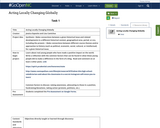
- Subject:
- 21st Century Global Geography
- Material Type:
- Lesson Plan
- Author:
- Jessica Esposito
- Date Added:
- 11/10/2019

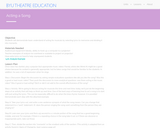
In this lesson, students will demonstrate basic understand of acting for musicals by selecting lyrics to memorize and dividing it into moments.
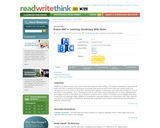
Students can work together to brainstorm and create lists of verbs for each of the letters of the alphabet in this interactive activity. Then, choosing one verb for each letter, or letters of their choice, they can create pages for an Action Alphabet book. Each page includes an illustration and a sentence using the verb in context or students can create a chart with all of the verbs listed.

By "becoming" a character in a novel they have read and making lists from that character's perspective, students analyze the character while also enriching their vocabulary. Students gain a deeper understanding of a character by creating charts linking the character's actions with the character's traits. They explore adjectives through a variety of resources. They then use their analysis of the character and their knowledge of adjectives to create descriptive lists of their own three other characters from the novel.
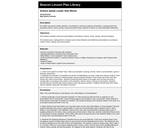
In this lesson, students will evaluate speeches according to volume, stress, pacing, and pronunciation, and examine the importance of these values in delivering an oral presentation.
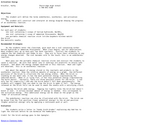
Students will investigate concepts related to endothermic and exothermic reactions and activiation energy. Students will construct and interpret an energy diagram showing the progress of an exothermic reaction.
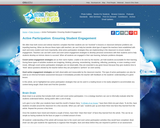
This article describes covert and overt active engagement strategies for use with elementary students. Find the Question templates are included for use with informational text.

This recurring lesson encourages students to comprehend their reading through inquiry and collaboration. They work independently to choose quotations that exemplify the main idea of the text, come to a consensus about those quotations in collaborative groups, then formulate "quiz" questions about their reading that other groups will answer.

Students will identify the differences between passive and active verb forms. Students will be given the opportunity to practice recognizing these verbs. Students will be able to identify these types of verbs within their own writings, and begin to wrtie in a more complete active voice than a possive one or a mistures of both.

This article discusses the four forms of identifying similarities and differences: comparing, classifying, creating metaphors, and creating analogies and how these strategies can be used in an elementary classroom.
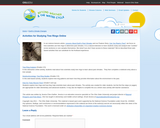
Selected resources provide three web-based activities to complement science lessons in an issue of Beyond Weather and the Water Cycle. The free, online magazine for Grades K-5 teachers explores the essential principles of climate literacy.

Students learn about vectors. There are a series of practice problems at the end of the lesson.
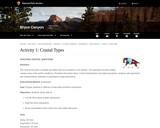
In this lesson, students experiment with representative materials to understand crustal interactions. By the end of the lesson, students will be able to list and draw the three types of plate interactions and name one landform that results from each plate interaction.

This hands-on activity allows students to re-acquaint themselves with magnets, magnetic fields and the concept of polarity.

In this activity, students will work in collaborative groups to develop an advertisement for a political candidate in support of one side of an issue - should we build low-cost housing on part of the land presently occupied by an estuary? Each group will decide which side they want to support - either for or against building the housing - and write an ad that will be run in a local paper, or that will be viewed on local TV, to support their argument.

In this lesson, students observe demonstrations and participate in hands-on activities that involve static electricity. Connections to everyday examples of static electricity and assessment ideas are included. Extension activities integrate Language Arts and family.

In this lesson, students determine the particle size and composition of a sample of soil. Soil composition determines many characteristics of soils, such as infiltration rates (the rate at which water moves into a soil), percolation rates (how fast water moves through the soil), settling rates (how fast sediments sink to the bottom of a body of water), oxygen content, and the ability of the soil to support plant and animal life.

In this hands-on activity students create a simple electromagnet with wire, a pencil, and a battery. Students will investigate factors that increase the strength of the magnet.

In this lesson, students complete water quality tests such as pH, dissolved oxygen, nitrates, phosphates, and salinity for a water sample. After following these activities, students should understand the purpose of these tests, know how to run accurate water quality tests, and see how these parameters relate to the quality of the water in an estuary.
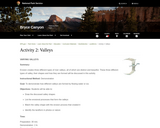
In this lesson, students demonstrate how different valleys are formed by flowing water or ice. Students list the erosional processes that form valleys and identify the landform in photos or in nature.